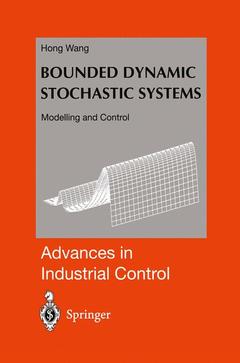Bounded Dynamic Stochastic Systems, Softcover reprint of the original 1st ed. 2000 Modelling and Control Advances in Industrial Control Series
Langue : Anglais
Auteur : Wang Hong

Over the past decades, although stochastic system control has been studied intensively within the field of control engineering, all the modelling and control strategies developed so far have concentrated on the performance of one or two output properties of the system. such as minimum variance control and mean value control. The general assumption used in the formulation of modelling and control strategies is that the distribution of the random signals involved is Gaussian. In this book, a set of new approaches for the control of the output probability density function of stochastic dynamic systems (those subjected to any bounded random inputs), has been developed. In this context, the purpose of control system design becomes the selection of a control signal that makes the shape of the system outputs p.d.f. as close as possible to a given distribution. The book contains material on the subjects of: - Control of single-input single-output and multiple-input multiple-output stochastic systems; - Stable adaptive control of stochastic distributions; - Model reference adaptive control; - Control of nonlinear dynamic stochastic systems; - Condition monitoring of bounded stochastic distributions; - Control algorithm design; - Singular stochastic systems.
A new representation of dynamic stochastic systems is produced by using B-spline functions to descripe the output p.d.f. Advances in Industrial Control aims to report and encourage the transfer of technology in control engineering. The rapid development of control technology has an impact on all areas of the control discipline. The series offers an opportunity for researchers to present an extended exposition of new work in all aspects of industrial control.
A new representation of dynamic stochastic systems is produced by using B-spline functions to descripe the output p.d.f. Advances in Industrial Control aims to report and encourage the transfer of technology in control engineering. The rapid development of control technology has an impact on all areas of the control discipline. The series offers an opportunity for researchers to present an extended exposition of new work in all aspects of industrial control.
1 Preliminaries.- 1.1 Introduction.- 1.2 An example: flocculation model.- 1.3 The aim of the new development.- 1.4 The structure of the book.- 1.5 Random variables and stochastic processes.- 1.6 Stochastic processes.- 1.7 Some typical distributions.- 1.8 Conclusions.- 2 Control of SISO Stochastic Systems: A Fundamental Control Law.- 2.1 Introduction.- 2.2 Preliminaries on B-splines artificial neural networks.- 2.3 Model representation.- 2.4 System modelling and parameter estimation.- 2.5 Control algorithm design.- 2.6 Discussions.- 2.7 Examples.- 2.8 Conclusions.- 3 Control of MIMO Stochastic Systems: Robustness and Stability.- 3.1 Introductionx.- 3.2 Model representation.- 3.3 The controller using V(k).- 3.4 The controller using f(y, U(k)).- 3.5 An illustrative example.- 3.6 Conclusions and discussions.- 4 Realization of Perfect Tracking.- 4.1 Introduction.- 4.2 Preliminaries and model representation.- 4.3 Main result.- 4.4 Simulation results.- 4.5 An LQR based algorithm.- 4.6 Conclusions.- 5 Stable Adaptive Control of Stochastic Distributions.- 5.1 Introduction.- 5.2 Model representation.- 5.3 On-line estimation and its convergence.- 5.4 Adaptive control algorithm design.- 5.5 Stability analysis.- 5.6 A simulated example.- 5.7 Conclusions.- 6 Model Reference Adaptive Control.- 6.1 Introduction.- 6.2 Model representation.- 6.3 An adaptive controller design.- 6.4 Adaptive tuning rules for K(t) and Q(t).- 6.5 Robust adaptive control scheme.- 6.6 A case study.- 6.7 Conclusions and discussions.- 7 Control of Nonlinear Stochastic Systems.- 7.1 Introduction.- 7.2 Model representation.- 7.3 Control algorithm design.- 7.4 Stability issues.- 7.5 A neural network approach.- 7.6 Two examples.- 7.7 Calculation of ?.- 7.8 Conclusions.- 8 Application to Fault Detection.- 8.1Introduction.- 8.2 Model representation.- 8.3 Fault detection.- 8.4 An adaptive diagnostic observer.- 8.5 Discussions.- 8.6 An identification based FDD.- 8.7 Fault diagnosis.- 8.8 Discussions and conclusions.- 9 Advanced Topics.- 9.1 Introduction.- 9.2 Square root models.- 9.3 Control algorithm design.- 9.4 Simulations.- 9.5 Continuous-time models.- 9.6 The control algorithm.- 9.7 Control of the mean and variance.- 9.8 Singular stochastic systems.- 9.9 Pseudo ARMAX systems.- 9.10 Filtering issues.- 9.11 Conclusions.- References.
Broaches new ground in considering a wide range of system output distributions Fault detection methods applicable in diverse control situations..
Date de parution : 10-2012
Ouvrage de 176 p.
15.5x23.5 cm
Date de parution : 02-2000
Ouvrage de 176 p.
15.5x23.5 cm
Thèmes de Bounded Dynamic Stochastic Systems :
© 2024 LAVOISIER S.A.S.



